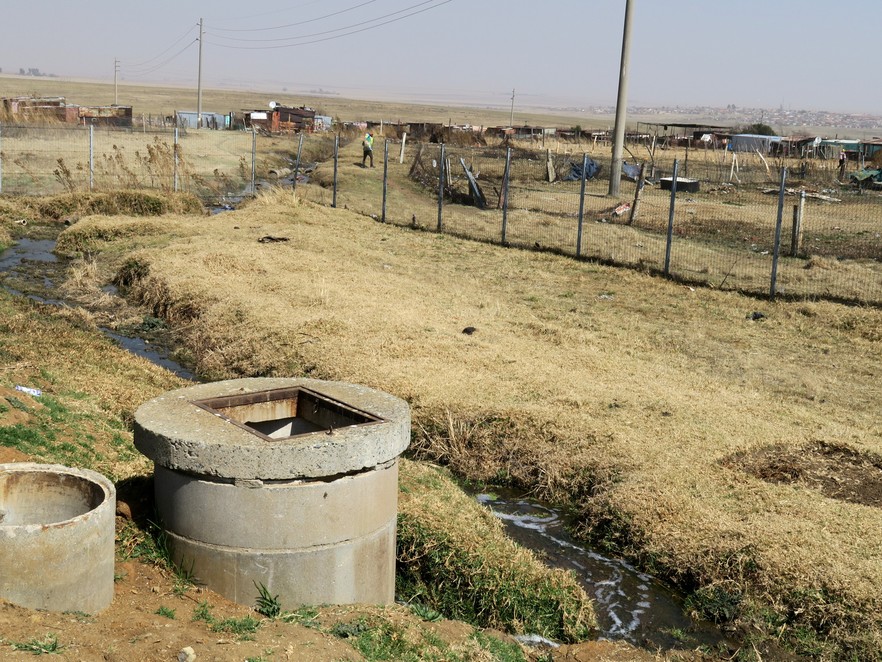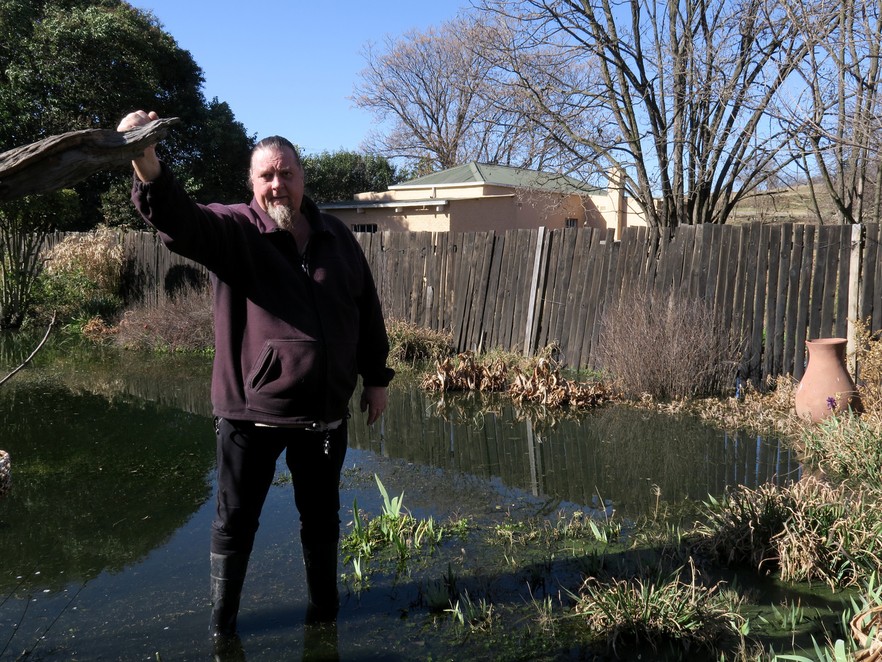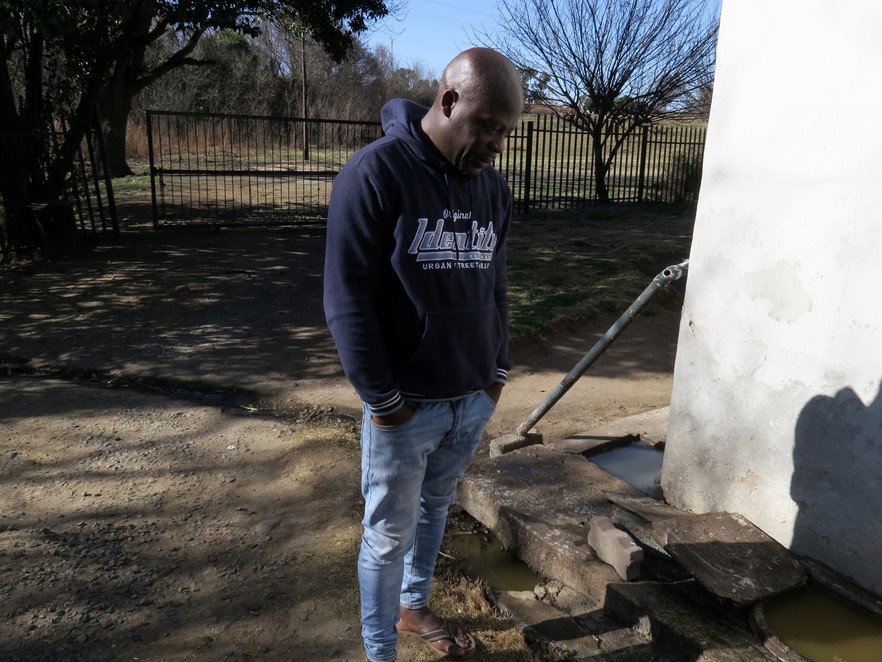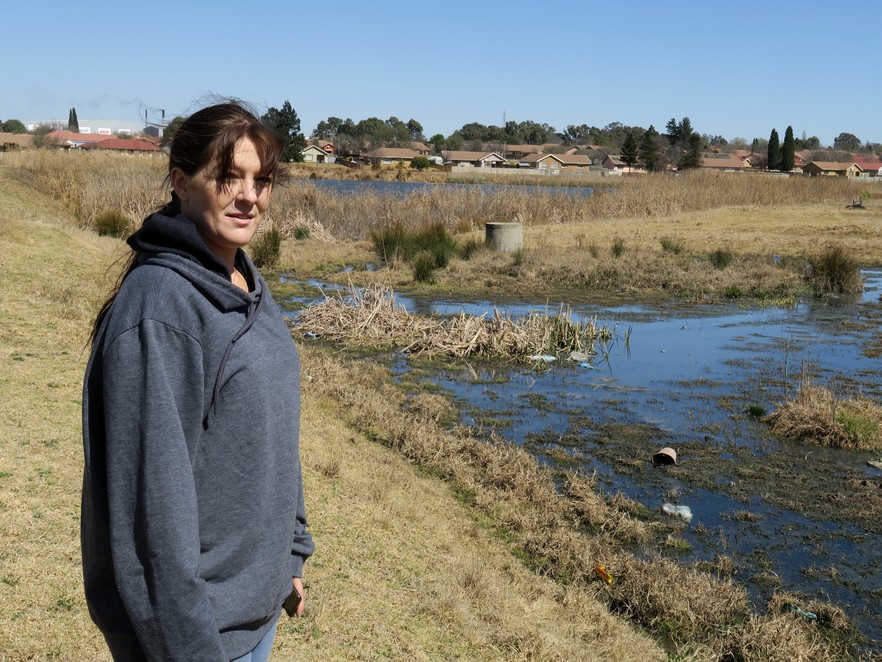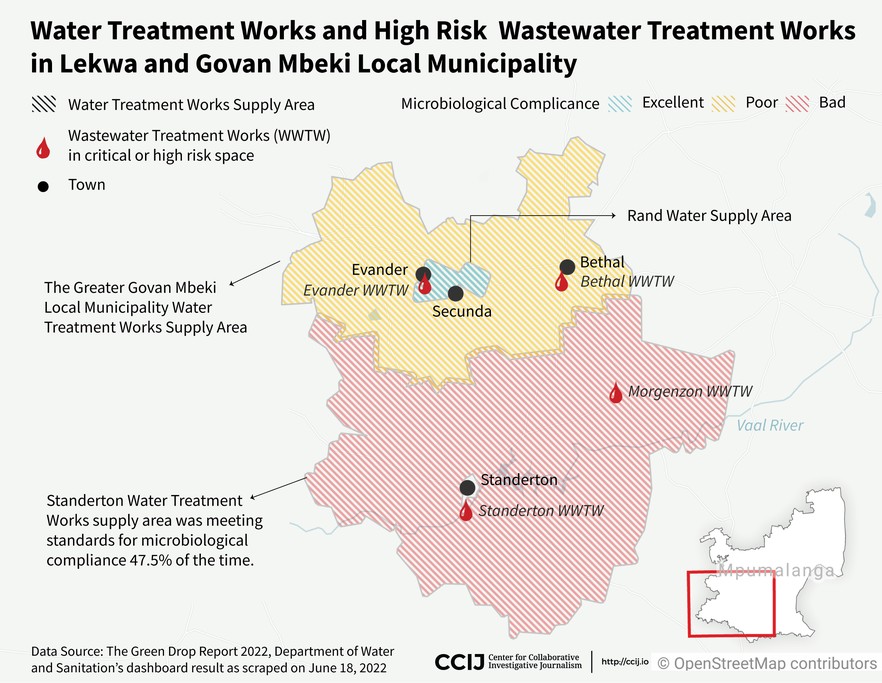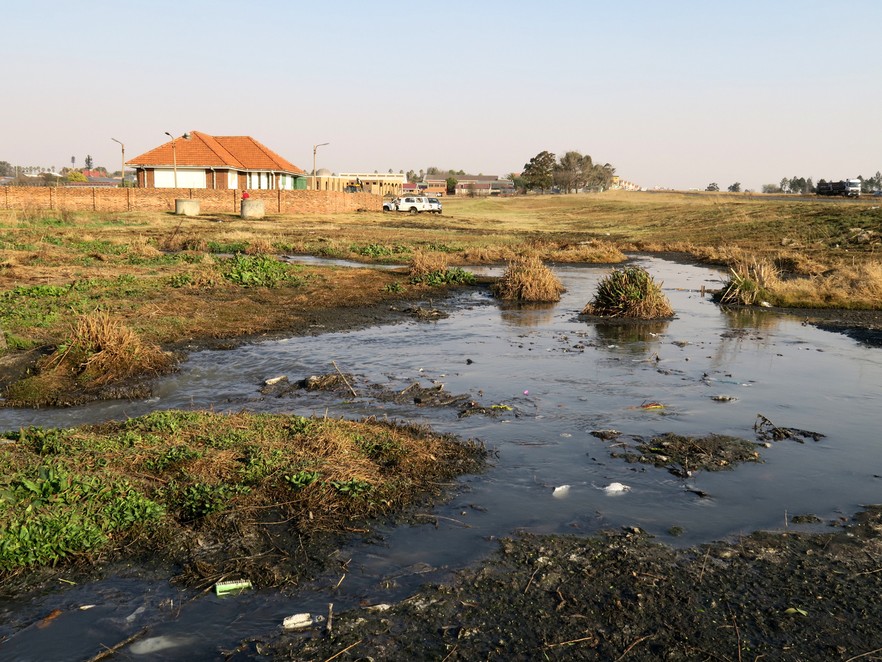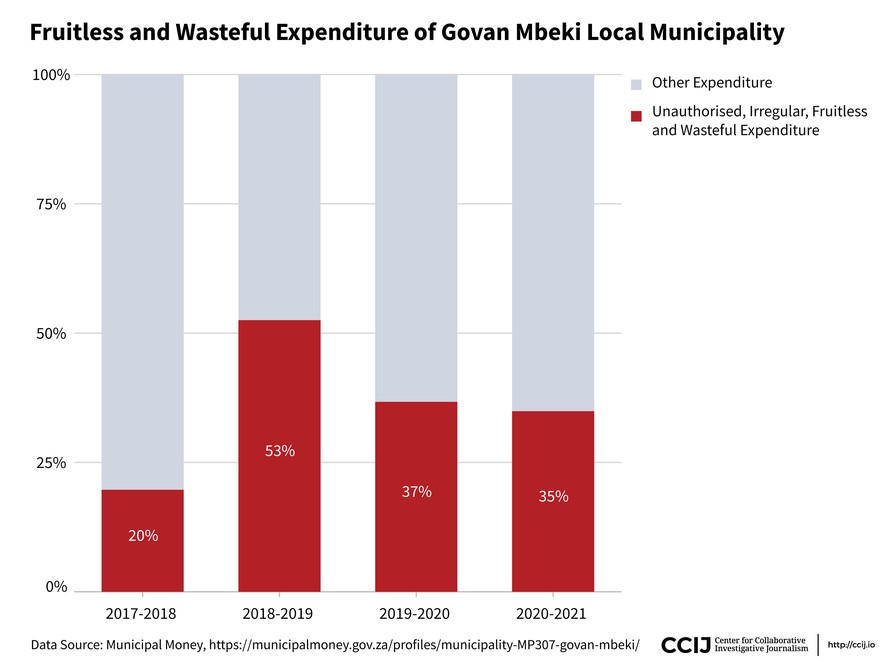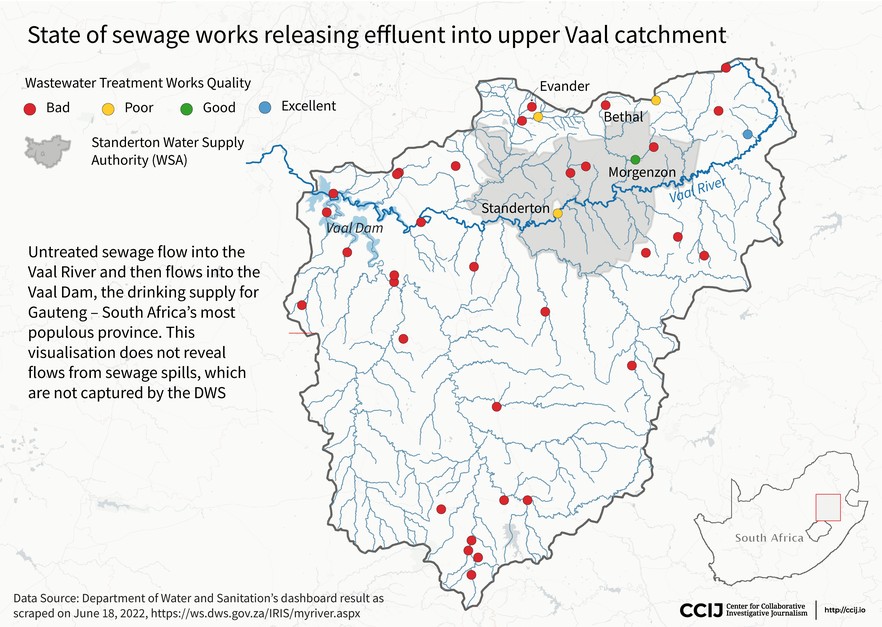Sewage seeps into Vaal Dam as Mpumalanga water treatment plants fail
Gauteng drinking water could be threatened if crisis is not fixed
A stream of sewage from holding ponds at the Bethal wastewater treatment works, which is supposed to be pumped back to the plant for treatment, flows from a break in the lowest pond’s wall through an informal settlement below. Photos: Steve Kretzmann
- Failing sewerage systems in Mpumalanga municipalities are pouring filthy water onto streets and into the Vaal River catchment system.
- In some municipalities not only sewage treatment plants but also water purification plants, where water is prepared for drinking, are failing.
- The catchment system supplies the Vaal Dam, which supplies water to Gauteng.
Johan Lotter and his parents moved into neighbouring houses in Standerton 15 years ago, planning to spend the rest of their lives there.
Located in a cul-de-sac on the banks of the Vaal River, the houses seemed ideal for Lotter, who had taken early retirement after the family plumbing business down-sized. He planned to look after his ageing parents and spend more time enjoying two of his favourite hobbies, gardening and baking, in between lecturing at a local technical college. But for the past three years, gardening has been out of the question, and baking is much less appetizing, as both properties have been flooded with sewage.
The houses are on the lowest residential portion of land in Standerton’s Meyerville area, where sewer line blockages and pump station failures have caused waste to back up and overflow, turning the properties into a permanent sewage swamp.
Lotter said the sewer line started to get blocked regularly in 2009. Blockages gradually became more frequent until the overflow became permanent in late 2018, with sewage engulfing their yards.
Johan Lotter stands in the yard of the family house, most of which is now a permanent swamp of raw sewage following complete breakdown of the municipal sewerage system since 2018.
The permanent saturation of the ground has caused the building’s foundations to give way. Lotter pointed out new cracks in the walls and rising damp that has led to black mould forming inside.
“I’ve developed asthma and am getting headaches,” he said. He now shares one house with his parents.
Living in a “garbage heap”
It’s a familiar story. Tulani Habile lives in the third house in the cul-de-sac. He shares it with his mother, sister, aunt, his 13-year-old son and his nine-year-old daughter. Although his house is on slightly higher ground, the town’s sewerage failure means his own drains are permanently blocked, and all the household waste water flows into the yard.
Habile also pointed to new cracks in the walls where the drain is situated – the result of the continual damp – and the stench from the sewage swamp that permeates the air. He says his children are teased at school for their living conditions.
“My daughter gets teased at school. Even friends she used to play with, they say ‘you’re staying in a garbage heap,’ and laugh at her. Her friends don’t visit anymore.”
He said it’s the same with his son, whose friends no longer come over to play soccer.
Tulani Habile says rising damp and cracks are beginning to form in his house in Standerton.
Entire town’s sewerage system is failing
The Lotter and Habile houses may be the most visibly affected, but the entire town’s sewerage network is failing.
A two-and-a-half hour tour across Standerton with municipal councillor Wilma Venter revealed sewage spill after sewage spill.
At a pump station on Taljaard Street, the security guard used stepping stones to cross a pond of sewage between her guard hut and the boundary gate. Although the pump station was working at the time, she said it is switched off from 5pm to 8am every night. During those 15 hours, the sewage simply overflows into the yard and across the street. She said she did not know why the pump was switched off. Venter also didn’t know why.
Wilma Venter points out one of many sewage spills in the town of Standerton. Having grown up in Standerton, she said as children they used to swim in the vlei behind her, which has since become a cesspool.
Venter, who was elected ward councillor for the area in November last year, was previously a community activist, and had been reporting sewerage failures to the municipality and pushing for action for five years. She showed GroundUp house after house marked by years of sewage spills. Behind an apartment block on Berg Street, she pointed to an open field that she said usually has a fountain of sewage spewing from it.
Venter said sewage had been overflowing for years. It was evident that entire lines were blocked or collapsed, sewage was spilling out of every manhole; across streets, into gardens, and into the Vaal River. Questions sent to the municipality asking why the sewerage network was dysfunctional were ignored.
But this report is not just about Lekwa municipality’s sewerage network failing – as it clearly is. Data from the entire region’s municipal wastewater plants show a pattern of lack of oversight and fiscal mismanagement, not only failing the people who live there, but potentially affecting more than 13 million people who rely on the Vaal Dam for their drinking water. It also offers a dire warning if no action is taken to rectify it.
Toxic water
According to the Department of Water and Sanitation (DWS) Green Drop Report for 2022 – an audit of all wastewater treatment works in the country for the period July 2020 to June 2021 – Standerton Wastewater Treatment Works is 164% over capacity, achieving an overall score of just 17%, which puts it into the “critical risk category”. No data on the quality of its effluent, which is released almost directly into the Vaal River, was loaded onto the DWS online regulatory system, which it is required to do on a monthly basis, during the first quarter of 2022.
A visit to the plant revealed untreated sewage spilling into the environment from just outside the perimeter fence, and flowing into the Vaal River a stone’s throw away. From there it flows into the Vaal Dam, the drinking supply for Gauteng.
The failure within Lekwa municipality is not confined to wastewater and pollution of the Vaal. The drinking water supplied by the municipality, which is extracted from the Vaal about a kilometre upstream of the town, is not drinkable.
The water from the taps “smells like ammonia” and is brown, said Lauren Nienaber, who lives at the bottom of Coligny Street with her husband Andre.
Andre revealed a small reverse osmosis system underneath the kitchen sink which they use to purify the water from their tap.
He said they have to change the filters every three months, costing R500 ($29), as well as a “main filter,” which costs R800 ($47). This is above what they have to pay the municipality for water use and supply.
“We don’t even cook with the tap water,” he said, it all goes through the purifier first.
Their perception is backed up by data on the DWS system. Figures from 18 June show Standerton Water Treatment Works, which purifies water for drinking and is run by Lekwa municipality, was meeting standards for microbiological compliance (fecal coliforms such as E.coli and enterococcus) just 47.5% of the time. The figure for chemical compliance was 0%. Both these indicators, among others, are supposed to meet the South African National Standards (SANS) for drinking water at least 98% of the time. This data is also available on a user-friendly wazi map.
To the north of Lekwa, drinking water in the towns of Evander and Secunda in the Govan Mbeki Local Municipality, is acceptable. The Govan Mbeki supply comes from Rand Water rather than from a municipal-run water treatment works.
Wastewater management, however, for which the municipality is responsible, is failing in these towns, and in Bethal which also falls within the Govan Mbeki municipality.
Evander resident Corrie Badenhorst led us to a non-functioning wastewater pump station in a field on the north west of town. All the sewage from its collection network flows across an open field, via a stream into the Grootspruit river. The Grootspruit runs south into the Waterval River, a tributary of the Vaal. Before contributing to pollution of the Vaal, the untreated sewage first flows into a wetland less than a kilometre away, which is visibly polluted. Wetlands are supposed to be protected under national environmental legislation for their ecological services (such as flood mitigation, groundwater recharge, biodiversity, carbon capture), but this pump station, which Badenhorst says is the only one in Evander, has been dysfunctional for “more than two months”. No visible action has been taken and no-one has been prosecuted.
The stream of sewage flowing from a broken pump station in Evander, Mpumalanga. The white vehicles in the background belong to a municipal crew who were restoring the power cables to the pump station, which had been stolen.
The Green Drop Report shows the Evander wastewater treatment plant scored just 17% for microbiological compliance, and 48% for chemical compliance, with an overall score of just 35%. An overall score of 31% or less indicates the plant is in “critical risk” and to be placed under regulatory focus.
The Govan Mbeki municipality did not respond to questions, including whether or not there was just one pump station in the sewerage network. If Badenhorst’s assertions are correct, the Evander wastewater treatment plant is failing even though it doesn’t get much of the sewage within the network, which mostly flows into the environment instead of to the treatment plant.
In Bethal, southwest of Evander in the same municipality, the wastewater treatment plant was not working at all when GroundUp visited on the morning of 18 August, due to loadshedding.
An employee at the plant, who is not allowed to officially speak to the media, said there is no generator and the plant is subject to national loadshedding schedules as well as power cuts due to municipal failures.
He said when they do have electricity at the plant, only one of four aerators work, and a biofiltration unit doesn’t work. This is largely due to cable theft, he said.
“As soon as they fix the cables, they get stolen again.”
Asked about a series of large holding ponds, he explained that when the wastewater flow contains high chemical levels, as well as blood from the abattoir, it is diverted to the ponds to settle. It is then supposed to be pumped back to the plant for treatment. But the return pump wasn’t working, so the water from holding ponds flowed through a break in the lowest pond, through an informal settlement and into the wetland.
“It’s flowing into the stream without treatment,” he said.
The Green Drop report gave the Bethal wastewater treatment works an overall score of 36%, placing it in the ‘high risk’ category, with microbiological compliance of 0% and chemical compliance of 58%.
The cost of mismanagement
Neither Govan Mbeki nor Lekwa municipalities responded to questions about failures in sewage or drinking water provision. But financial records, reflected on Municipal Money – a web-based tool designed to inform citizens on their municipality’s financial performance using data from the National Treasury – indicate the extent of mismanagement.
According to the data, Govan Mbeki Municipality underspent its capital budget by more than 54% in the last reported financial year (2020/21). The capital budget is used for infrastructure projects such as new water pipes or wastewater treatment plants. Equally, spending on repairs and maintenance, which would cover the preservation of sewerage and water supply networks, was a mere 2.5% of the value of the municipality’s fixed assets, when it should be 8%.
“Unauthorized, irregular, fruitless and wasteful expenditure” comprised nearly 40% of the budget in the last financial year. It was nearly 38% of the 2019/20 budget and more than half of the budget in the 2018/19 financial year.
While data and anecdotal evidence show Govan Mbeki municipality’s drinking water meets national standards, the Auditor-General in its qualified report, noted 7.7 billion litres of this water was lost during the financial year “due to wastage as a result of deteriorating infrastructure.”
The municipality incurred a net loss of nearly R609-million ( for the financial year, and liabilities exceeded assets by more than R195- million, leading the Auditor-General to state there is “a material uncertainty” whether the municipality has the resources to continue operating.
Lekwa municipality’s financial state is possibly worse, with the Auditor-General’s office stating the municipality was unable to provide sufficient documentation for an audit opinion to be formed. The Auditor-General accounting officers stated in their report that if the audit of the municipality had not been required by legislation, they would “have withdrawn from the engagement in terms of the International Standards of Auditing.” In other words, if the municipality were a business, it would not be able to produce properly audited financial reports.
Damningly, the Auditor-General found the municipal infrastructure grant, which is provided by the national government for infrastructure to service the poorest households, was “not spent for its intended purpose”.
Due to the poor reporting and financial record keeping, there is little information from the 2020/21 or 2019/20 financial years loaded onto the Municipal Money site. However, it shows “unauthorized, irregular, fruitless and wasteful expenditure” took up more than 40% of the budget in 2019/20. The Auditor-General notes that no reasonable steps have been taken to prevent this loss of money.
The result of this mismanagement is more than 57 million litres of untreated or partially treated sewage flowing to the Vaal River every day, just from these two municipalities in one corner of the vast upper Vaal catchment area. Beyond sewage pollution, this catchment also receives agricultural runoff containing high levels of nitrates and phosphates, as well as acid mine drainage, all of which goes into the only supply of drinking water for much of Gauteng Province, as well as parts of Mpumalanga, such as Govan Mbeki municipality.
A dire warning
These areas form South Africa’s economic heartbeat, but Rand Water, the bulk water supplier for this region, did not answer questions about the impact of sewage and other pollution on the drinking water supply from the Vaal Dam. They said the questions fell under the competence of the Department of Water and Sanitation, who failed to respond. However, a water quality specialist at Rand Water, who cannot be named for fear of losing his job, issued a dire warning if the matter is not addressed.
He explained that the microbiological component in the untreated water – E. coli and related gut bacteria – does not last long outside the human gut, so is not a factor by the time the water flows to the Vaal Dam, and even if it was, the microbes would be killed by chlorine. However, the chemical components - the nitrates and phosphates - do remain. The water purification process is designed to remove these elements and so far is doing so within specified limits. This is partly because the Vaal Dam is so large, which allows for sufficient dilution, and partly because good rainfall seasons have prevented the build up of chemicals.
So far, he said, the cost of water purification has not been affected by the pollution of the catchment area. “But if it gets to that point, it would be drastic,” he said.
He said this might take a decade or more. But, he said, increased pollution from dysfunctioning municipalities, population growth, a failure to deal with acid mine drainage and agricultural runoff, combined with a few years of drought as experienced by Cape Town in 2017, that could push the Vaal Dam to a point of eutrophication. This occurs when an influx of nutrients, like nitrogen and phosphorus, stimulates algal growth to the point where oxygen is removed from the water, making it incapable of supporting life. Eutrophication also leads to blooms of cyanobacteria (commonly known as blue-green algae) which produce toxins that can be fatal. Studies show that once a water body has become eutrophic, it may take a thousand years for it to recover.
The Rand Water employee said eutrophication of the Vaal Dam was “a long way off,” but warned that “if we get to that point,” there would be nowhere else to go in terms of water supply for the roughly 10 million people who rely on the dam for drinking water.
For Anthony Turton, a professor at the University of Free State’s Centre for Environmental Management, who is also a specialist in acid mine drainage, there is “no question” that the Vaal Dam is already moving toward a eutrophic state.
Turton cited several studies showing around 60% of large dams in South Africa had become eutrophic. “We’ve never managed to turn it around,” he said.
Current bulk water treatment methods, said Turton, cannot remove the toxins produced by blooms of cyanobacteria. These toxins, he said, have been proven to injure motor neurons in the brain, impairing cognitive function. They can also cross the placenta, accumulating in the brain of the foetus.
Water from a eutrophic dam can be purified to drinking water quality through charcoal activation or advanced oxidation, Turton said. But he said neither of these methods are currently in use.
While Johan Lotter and his parents have to live in a fecal swamp, a national water security crisis is creeping ever closer with each kilolitre of untreated water that flows into the Vaal from these failing municipal systems.
Support independent journalism
Donate using Payfast

Don't miss out on the latest news
We respect your privacy, and promise we won't spam you.
Next: Mbalula sticking to December deadline to fully open Cape Town’s Central Line
Previous: Anger at civil society exclusion from Presidential summit
© 2022 GroundUp. This article is licensed under a Creative Commons Attribution-NoDerivatives 4.0 International License.
You may republish this article, so long as you credit the authors and GroundUp, and do not change the text. Please include a link back to the original article.
We put an invisible pixel in the article so that we can count traffic to republishers. All analytics tools are solely on our servers. We do not give our logs to any third party. Logs are deleted after two weeks. We do not use any IP address identifying information except to count regional traffic. We are solely interested in counting hits, not tracking users. If you republish, please do not delete the invisible pixel.

